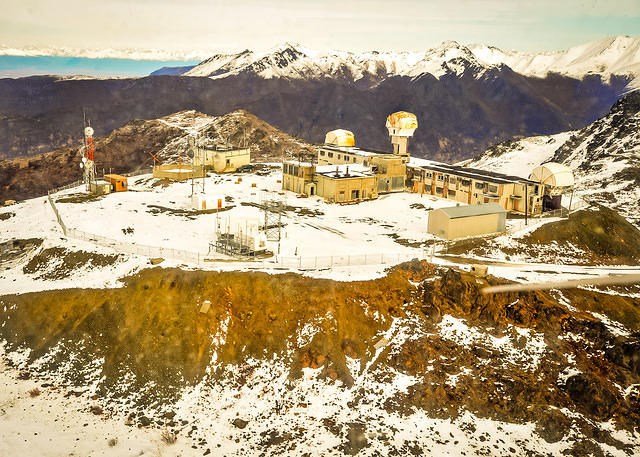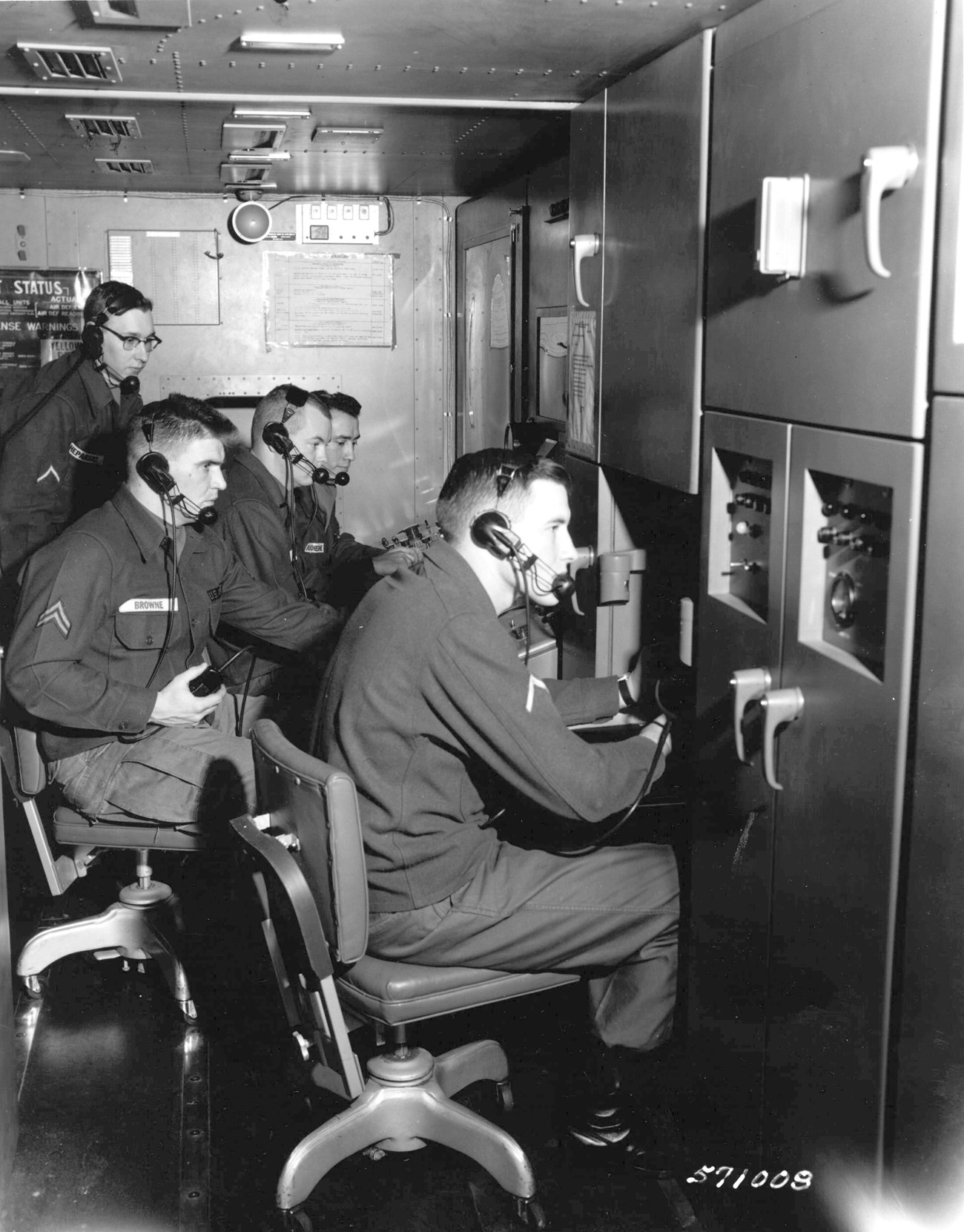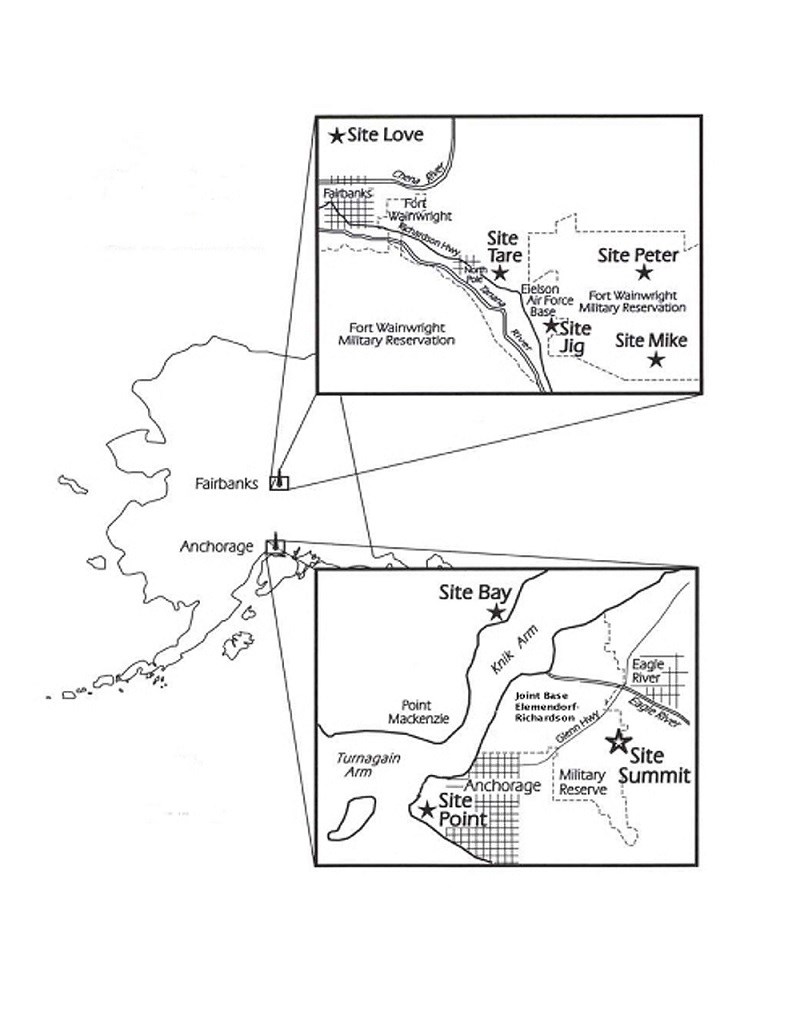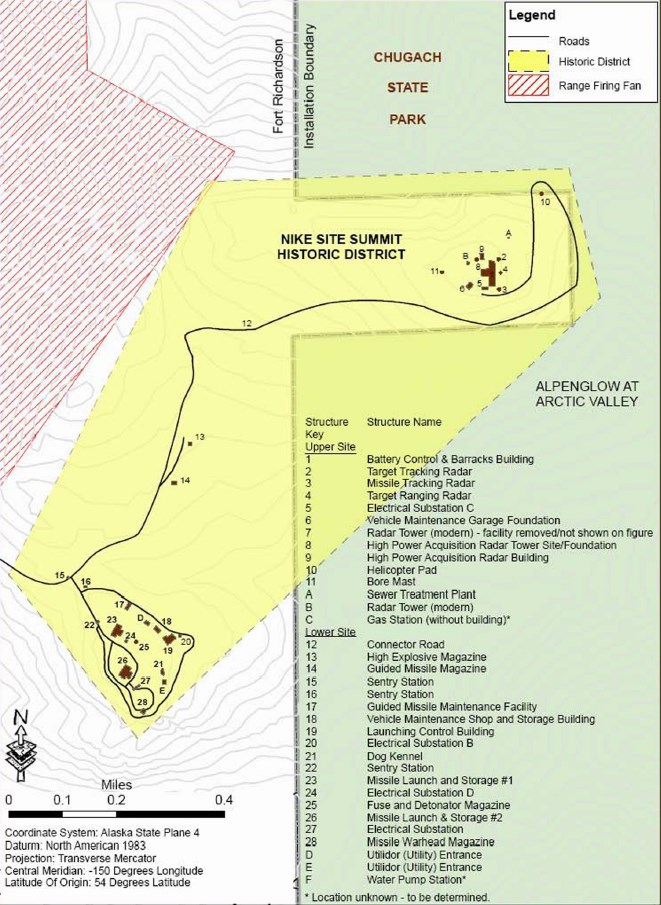Last updated: March 30, 2023
Article
Alaska's Site Summit: Cold War Defense and its Legacy in the North (Teaching with Historic Places)

(Photo by Laura Turner, courtesy of the U.S. Air Force)
This lesson is part of the National Park Service’s Teaching with Historic Places (TwHP) program.
Atop Mount Gordon Lyon, nearly 4,000 feet above the city of Anchorage, Alaska, the wind howls above 120 miles per hour, snow drifts 10 feet high, dirt and rocks blow hard enough to cause damage to anything man-made, and the terrain is rugged and desolate. In the midst of this disagreeable environment stands a reminder of the people who sacrificed their comforts to protect their country during the Cold War: Site Summit.
Nike Hercules was a nationwide ground-based anti-aircraft missile system that protected the U.S. during the Cold War. One of the three Nike sites in Anchorage, Site Summit, stood guard over Anchorage from 1959 to 1979. The site operated 24/7 and it was one of the few Nike sites in the United States to remain operational through the entire twenty years that the Nike Hercules system was in use.
Site Summit is a testament to engineering ingenuity in the face of tremendous challenges to its construction: isolation, difficult access, high winds, extremely cold temperatures, and raging snow storms presented a challenge to those constructing Site Summit and those who served there. Today, it is one of the best-preserved Nike sites and is listed in the National Register of Historic Places.
About This Lesson
This lesson is based primarily on the National Register of Historic Places registration file “Site Summit” (with photos) and primary sources detailing the Cold War in Alaska. This lesson plan was a collaborative effort of archeologist Phyllys Callina, the Friends of Nike Site Summit, the Alaska Historical Society, and the U.S. Air Force. It was edited by the Teaching with Historic Places staff. This lesson is one in a series that brings the important stories of historic places into the classrooms across the country.
Where it fits into the curriculum
Topics: The lesson could be used in U.S. history, social studies, and geography courses in units related to the Cold War.
Time period: Late 1950s to early 1990s
Objectives for students
1) To explain Alaska’s role in the Cold War and how the military used its geographically-strategic position;
2) To identify the challenges and the strategic advantages of Site Summit to the U.S. military;
3) To describe the Nike-Hercules missile system and its purpose during the Cold War;
4) To explain the effects of the Cold War on Alaska’s economy and demographics;
5) To evaluate how the Cold War affected the lives of Americans in their own communities.
Materials for students
The materials listed below can be used directly on the computer or can be printed out, photocopied, and distributed to students. The maps and images appear twice: in a smaller, low-resolution version with associated questions and alone in a larger version.
1) two maps including one of Nike sites in Alaska during the Cold War and one of Site Summit;
2) three readings about the Cold War, Alaska during the Cold War, Nike program in Alaska and Site Summit;
3) six photos of life, landscape, and military operations at Site Summit.
Visiting the site
Site Summit is located in a regulated area of Joint Base Elmendorf-Richardson in Anchorage, Alaska. Military clearance is required to visit the site. The only way to visit Site Summit is with a guided tour. Tours are conducted from June through September by the volunteer group Friends of Nike Site Summit. Visit their website for contact and scheduling information.
Site Point is more easily accessible. It is now Kincaid Park in Anchorage, Alaska: a public recreation area operated by the Municipality of Anchorage. One of the Nike Hercules missile silos and a bunker were used in the construction of the Kincaid Outdoor Center. This park is open to the public year-round.
Getting Started
Inquiry Question

(Photo by Colt Denfield, courtesy of the U.S. Army)
Setting the Stage
|
The Cold War was characterized by strained relations between the United States and the Soviet Union, but the two countries have not always been at odds with each other. Between 1741 and 1959, both countries had claims to Alaska and both played significant roles in the development of the territory. |
Locating the Site
Map 1: Nike-Hercules Sites in Alaska.

(U.S. Army)
Nike sites were anti-aircraft missile bases that protected the United States during the Cold War with Russia. Nike bases were built in rings around areas that needed protection, like military bases and big cities.
Questions for Map 1
1) Find Alaska on a world map. What countries is it close to? What strategic role would Alaska play in a war with Russia?
2) Why do you think the Alaskan Nike sites were built in Fairbanks and Anchorage?
3) How might new military bases near a city affect the community? What do you think the people in Anchorage thought of Site Point, Site Bay, and Site Summit?
4) What effects do you think the Cold War may have had on Alaska and Alaskans?
Locating the Site
Map 2:Site Summit Historic District.

(U.S. Army Garrison-Alaska)
Site Summit is a 244-acre abandoned military site. It is located on top of Mount Gordon Lyon in the Chugach Mountains, 12.5 miles east of downtown Anchorage, Alaska. The site is divided into two parts. The Battery Control area is the highest part of the site, at 3,900 feet. The lower part of the site is the Missile Launch and Storage area. It sits at 3,100 feet.
Questions for Map 2
1) What kinds of buildings are at the upper part of Site Summit? What kinds of buildings are at the lower part?
2) Why do you think a mountain might be a good place to launch a missile?
3) What challenges do you think the military faced when it built Site Summit?
4) According to the National Register of Historic Places, a historic district "possesses a significant concentration, linkage, or continuity of sites, buildings, structures, or objects united historically or aesthetically by plan or physical development." What kinds of historic features does Site Summit have that are not buildings? What do you think these features can tell us about life at Site Summit during the 1960s?
Determining the Facts
Reading 1: The United States Enters the Cold War
World War II left the United States and Soviet Union as the two world’s superpowers, two superpowers with very different values and agendas. Because the alliance between the United States and Soviet Union was created out of necessity and not based on a solid foundation of shared values or beliefs, the relationship quickly deteriorated after the end of World War II. The United States practiced and advocated democracy and a free market. It supported capitalism. The Soviet Union practiced communism with less free enterprise and less support of public dissent from its citizens. The United States and the Soviet Union "fought" each other indirectly for the next 40-45 years as each country competed to spread their own forms of government throughout the developing world.
In addition to their competing world views, the leaders of the United States felt the nation was threatened when the Soviet Union detonated a nuclear device in 1949. The United States was the only country with nuclear weapons until that year. The Korean War started one year later. That war was the first proxy war of the Cold War. Proxy wars were localized, armed conflicts that the superpowers participated in by supporting other nations and groups. Proxy wars were not fought in the United States or in Russia. The Vietnam War and the Nicaraguan Civil War were also proxy wars. These “hot” wars were officially fought between sides allied with the United States or Russia, but those two superpowers made the hot wars bigger with money, training, soldiers, and weapons.
This indirect fighting is called the Cold War because it was not like most wars, when nations fight each other in violent battles. The United States and the Soviet Union raced to make more-powerful weapons and have more of them than the other country. Leaders in the United States and Russia wanted these weapons so their nations would look so strong that no one would attack them. Both nations did everything possible to avoid a direct hot war with each other, because both nations wanted to avoid a devastating nuclear war. Americans and Russians did not know what the other side was going to do, but at the time it seemed like the question was not if a real war would happen, but when it would happen.
One of the most-important defensive weapons the United States made but never used was the Nike missile system. The U.S. military decided to create a strong anti-aircraft weapon because of the fast and dangerous aircraft and missiles Germany made during World War II. The military wanted a surface-to-air guided missile system that could stop and destroy attacking planes. The Nike system was made by Bell Laboratories, Western Electric Company, and Douglas Aircraft between 1945 and 1953. The system was made up of the missiles plus the computers and radar equipment that guided the missiles. It was named “Nike” after the Greek goddess of victory. The different types of missiles used in the Nike system had their own names. The Nike-Ajax was the first missile model and it was set up in Fort Meade, Maryland, in 1954. The Army placed other Nike missiles around major cities and military bases that they believed the Soviets wanted to attack.
The second Nike missile model was the Nike-Hercules. It replaced Nike-Ajax in June 1958. This better model could stop a whole group of supersonic enemy bombers. It worked at high or low altitudes. The Nike-Hercules was "fifteen times as effective" as the Nike-Ajax, according to a 1958 press release. A Hercules missile could travel 87 miles and it was easy to steer with the computers. It was fast, flying more than 2,600 miles per hour. The missile also had a stronger warhead that could be high explosive or nuclear. The Nike system was the best Army anti-aircraft weapon. There were 274 Nike-Hercules bases in the United States and more than 10,000 missiles by the early 1960s.
The Air Force and Army shared the task of defending the United States against airplane and missile attacks. But the Army and Air Force disagreed about who would run the ground-based air defense. In the end, the Army won command of the ground-based air defense. Key control over fighting enemy bombers was given to the Air Force. The Army Anti-Aircraft Command was formed in July of 1950 to run the ground-based air defense. It was renamed the U.S. Army Air Defense Command in 1957. In 1968, the Air Defense Artillery Branch was created. The Army still runs the country’s ground-based air defense weapons today.
Questions for Reading 1
1) Why were the United States and the Soviet Union enemies after World War II?
2) What are Nike-Ajax and Nike-Hercules? Why did the United States build Nike missile launch sites during the Cold War?
3) What is the difference between a "hot" war and a “cold” war? How did the Nike system support a “cold” war rather than a “hot” war?
3) How many Nike-Hercules sites were there by the 1960s? How many missiles did the United States supply them with? What effects do you think this system may have had on the Soviet Union’s own military strategy?
Determining the Facts
Reading 2: The Cold War in Alaska
During the Cold War, Alaska was called the "Guardian of the North" and "Top Cover for America” because it was the first line of defense. The U.S. military realized Alaska’s strategic value during the era’s early years. The shortest and most likely route of attack from the Soviet Union was through Alaska. The Soviets could fly their fleet of bombers into the United States, using a route over the North Pole to drop nuclear weapons. The U.S. built a chain of radar stations in Alaska because of this danger. The radar could warn the United States about an incoming attack from the Soviet Union.
The military invested in Alaska’s defensive position. One defensive plan it installed in Alaska was the permanent radar system called the Distant Early Warning (DEW) Line. The system cost hundreds of millions of dollars. It was built across Alaska and would be able to warn the United States of an attack. Other radar systems were built, too. These other systems included the White Alice Communications System and the Ballistic Missile Early Warning sites. They were built in the 1950s, when Alaska was still a territory. If any of these radar systems spotted an incoming attack that alerted Project Nike to fire the missiles that could bring down enemy airplanes. By the 1960s, the radar systems and Project Nike formed an important part of North America’s defense system.
The Nike-Hercules system was part of Project Nike. In 1955, the military decided to add the Nike-Hercules system to Alaska. Bases were built near Anchorage and Fairbanks to protect the cities as well as the Army and Air Force bases near these cities. Missile facilities were built in Alaska between 1957 and 1959, three of them near Anchorage, and five near Fairbanks. Site Summit in Anchorage protected Fort Richardson Army Base, Elmendorf Air Force Base, and the City of Anchorage. Fort Richardson and Elmendorf are now called Joint Base Elmendorf-Richardson. The other Nike bases near Anchorage were Site Bay, located across Knik Arm near Goose Bay, and Site Point, located near Point Woronzof.
Alaska was important to the United States during the Cold War and the Cold War was also very important to Alaska. The Cold War is the reason why many roads, railroads, and communities in Alaska exist today. The infrastructure that the military built in Alaska encouraged Americans from the Lower 48 to move to Alaskan cities. Private citizens and private industries invested more money in Alaska’s economy.
The military’s experience in Alaska helped private companies drill for oil, build on permafrost, and build big pipelines in Alaska. The leaders of the United States did not want the nation to rely on other countries for energy. Companies began to look for oil on Alaska’s North Slope. The lessons that the military learned about how to work and build in dangerous, cold climates helped oil companies drill for and extract the oil they found. What the military knew also helped companies build on permafrost, which is hard ground that stays frozen year-round and is difficult to build on. Companies had to know how to build on permafrost to build the Trans-Alaska Pipeline System. The 800-mile-long pipeline carries oil from the North Slope to Valdez. Super tankers carry the oil from Valdez to refineries where it is made into different oil-based products, including gasoline. It is one of the world’s longest oil pipelines.
New roads, utilities, towns, and military bases also brought new people to Alaska. The government expanded its army forts and naval air stations. The world's longest airplane runway was built at Eielson Air Force Base in Fairbanks in 1946. Alaska’s population tripled between 1945 and 1970. It grew from 79,000 people to 220,000. The population also became more diverse. Military personnel and their families moved to Alaska from all over the United States. More than half of the population in some of Alaska’s remote communities worked for the military.
Alaska’s growth led to the territory becoming a state in 1959. Some long-time residents, businesspeople, members of Congress, and even President Eisenhower did not want Alaska to become a state. Political economist George W. Rogers wrote in 1962, "without the influx of new population and prosperity brought in by Military Alaska, it is doubtful that Alaska would today be a state."
All of these people brought a lot of money to Alaska. The military projects hired many local people as construction workers. The projects also brought soldiers to Alaska. All of these people spent money in Alaska’s shops and businesses. Businesses made more money. Oil companies and oil workers brought more money to Alaska in 1977. The Prudhoe Bay oil fields opened that year and the oil industry outdid the military in overall contributions to Alaska's economy and development. Military money continued flowing into the new state and the military presence remained important to Alaska’s economy into the 21st century.
Questions for Reading 2
1) What role did Alaska play in the United States' Cold War defense?
2) How did the Cold War change Alaska?
3) Why did people move to Alaska during the Cold War? Apart from being in the military, what other kinds of jobs do you think the newcomers worked? Why?
4) Do you think the defensive roles of Alaska have changed since the Cold War ended? Why or why not? What role in the United States' security do you think Alaska might play today?
Reading 2 was adapted from Siedler, W. J. (1996) February. The Coldest Front: Cold War Military Properties in Alaska. Draft. Office of History and Archaeology, Alaska Department of Natural Resources and United States Department of Defense Legacy Resource Management Program.
Determining the Facts
Reading 3: Site Summit Standing Guard
Alaska’s Site Summit was a Nike-Hercules missile facility and part of the Nike Project. An active missile facility from May 1959 until July 1979, it is a preserved example of an American military defense site in the Cold War. During the 1960s, the military did live practice firings from the site to prepare for a “hot” war with the Soviet Union. Site Summit was one of just a few sites where test fires were done. These test firings were a display of readiness. They showed Americans that the site was prepared to protect the Army and Air Forces bases and the City of Anchorage, as well as the Lower 48, from a Soviet attack.
In April 1957, the Army Corps of Engineers worked with a contracting company in Anchorage to build the three Anchorage Nike facilities for about $10 million. The companies began building Site Summit in May 1957 and finished it in September 1958. The Nike Project equipment arrived in February 1959 and the battery became active three months later.
COMMAND AND PERSONNEL
The Army was in charge of running the Nike facilities. Two battalions ran the Nike facilities in Alaska. One battalion was headquartered at Fort Richardson near Anchorage and one at Fort Wainwright near Fairbanks.
The Anchorage battalion was made up of four batteries at Site Summit, Site Bay, and Site Point. A battery generally has two launch structures. However, Site Point was a double battery, which means it had four launch structures. Each battery had a control station and two missile launch and storage structures with four launchers.
A Nike facility usually needed 125 soldiers to operate. Only 50 men could live there, so some soldiers drove to and from the facility daily. The site was staffed 24 hours a day, seven days a week. For security reasons, the enlisted men knew only their specific job, whether it was running the radars or assembling missiles.
The Nike missiles were not always stored at the facility. A building at Mile 3 of the Glenn Highway housed nuclear missile warheads. The warheads could be transported to Site Summit.
NIKE MISSILE SYSTEM OPERATION
The Nike missile system included radars for tracking enemy airplanes and a computer to guide a missile to its target. The radars were located at the Battery Control area. The computer was located in a radar control van that was parked inside the mechanical area of the Battery Control Building. Two acquisition radars swept the sky looking for enemy airplanes. Once one spotted an enemy target, the tracking radar locked onto the target and sent information about the enemy airplane to the computer and the missile. The target ranging radar kept the enemy from jamming the tracking radar. When they wanted to fire the missile, the Battery Control Officer commanded the Launch Control Officer, in the Launching Control building, to push the "fire" button. The radars and computer kept the missile on target once it was launched. The missile warhead exploded on command from the computer when the missile got close to its target.
LIVE MISSILE FIRINGS 1960-1963
Alaska Nike missile facilities Site Summit and Site Peter were among the few sites in the United States that fired missiles for practice. The people who worked at all of the other Nike facilities in the United States traveled to Fort Bliss, Texas, to use the White Sands Missile Range for their yearly practice firings. Fort Bliss was the Army's testing center for missiles and rockets.
The first live Nike missile practice firing from Site Summit was on November 20, 1960. This was one year after the first practice firing in Alaska took place at Site Peter. The Army practiced firings from Site Summit for four years in November and December, between 1960 and 1963. The missiles flew northeast towards Mount Witherspoon. The Army always posted the schedule of the firings in the Anchorage newspapers. The firings could be seen from most parts of Anchorage. Many of Anchorage’s residents took time out of their day to watch the firings. Children even got time out of school to watch them!
The Army cancelled practice firings from Site Summit in July 1964. The population of Anchorage increased so much since 1960 that it was no longer safe to fire practice missiles in the area. After this, the Anchorage battalion went to Fairbanks for yearly practices that lasted until 1968. Many live practice firings happened in Alaska, but the Army never used Alaska’s Nike missiles against a Soviet attack.
SUMMARY
The Army started closing the Nike facilities in 1965. The Nike system could not stop new kinds of missiles like the intercontinental ballistic missiles. The Army developed a new missile called the Patriot to fight the new missiles. The Fairbanks Nike facilities closed in 1970 and 1971. The last facilities in the country to close were in Alaska and Florida. Site Summit closed in July 1979, but the Army guarded it until 1986.
At the beginning of the 21st century, Site Summit is the most complete Nike facility in Alaska. It is better-preserved than other Nike sites from the Cold War. Special features not found at Nike facilities in the Lower 48 make it unique among all of America’s preserved Nike facilities. Alaska’s cold, subarctic weather demanded that special features at Alaska's Nike sites. For example, the radars at the battery control area needed covers. Heating coils inside the blast pad kept it clear of snow and ice. Underground tunnels held the power, heat, water, and communication lines. Evidence of these weather-braving additions is present at Site Summit. The historic site is preserved as a reminder of an unstable, uncertain period in American history as well as a reminder of how Alaska transformed from a territory into the 49th state.
Questions for Reading 3
1) What challenges and dangers did the U.S. Army face at Site Summit?
2) How did the Army overcome the geographical challenges? How did it take precautions against human threats?
3) How do you think people in Anchorage felt about the practice firings? How do you think people in California or Texas felt about the practice firings in Alaska?
4) If an archeologist discovers Site Summit 1,000 years from now, what do you think the place and its features could tell him or her about Alaska in the 1960s? Name a few features and explain what they could reveal.
Reading 3 adapted from National Park Service. 1996. National Register of Historic Places Registration Form: Site Summit.
